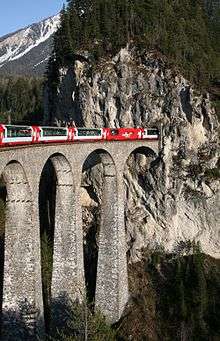Albula Tunnel
.jpg) View from the Spinas portal | |
| Overview | |
|---|---|
| Line | Albula Railway |
| Location | Albula, Graubünden, Switzerland |
| Coordinates | 46°34′30″N 9°48′32″E / 46.57500°N 9.80889°ECoordinates: 46°34′30″N 9°48′32″E / 46.57500°N 9.80889°E |
| Status | Open |
| System | Rhaetian Railway |
| Operation | |
| Work begun | 1898 |
| Opened | 10 July 1904 |
| Owner | Rhaetian Railway |
| Operator | Rhaetian Railway |
| Traffic | Train |
| Character | Passenger and freight |
| Technical | |
| Length | 5,865 m (19,242 ft) |
| No. of tracks | Single track |
| Track gauge | 1,000 mm (3 ft 3 3⁄8 in) |
| Electrified |
Overhead catenary, 11 kV AC 16 2/3 Hz |
| Highest elevation |
1,820 m (5,970 ft) above sea level |
The Albula Tunnel is the centrepiece of the Albula Railway, which forms part of the Rhaetian Railway network, in the Canton of Graubünden, Switzerland. With its maximum elevation of 1,820 m (5,970 ft) above sea level, it is amongst the highest tunnels in the Alps,[1] and has a mountain overlay of up to 950 m (3,120 ft). The tunnel has a length of 5,865 m (19,242 ft).[2]
The northern portal of the tunnel is at Preda, in Bergün, and the southern portal at Spinas, in the Bever valley. At a total length of 5,865 m (19,242 ft), the tunnel connects the Albula Valley with the Engadin Valley, and, in so doing, passes under the watershed between the Rhine and the Danube a few kilometres west of the Albula Pass.
The tunnel serves both passenger and freight traffic. The Glacier Express passes through it daily. Until 2011 during the Winter car transporter trains operating between Thusis and Samedan also used the tunnel.
History
The construction of the tunnel caused unusual problems. The cold, 6 °C (42.8 °F), water outflows transformed the already fractured rock into a pulpy mass, regularly clogging up the shell of the northern tunnel lead (or adit). At the same time, a strong water source above the northern tunnel portal dried up. The water streaming in at 300 L/s (66 impgal/s; 79 USgal/s) had to be painstakingly diverted with pipelines. As a result, construction virtually came to a standstill: in the ten weeks from May 1900, only two metres (6.6 ft) of tunnel were driven. These difficulties could not be overcome by the head construction contractor Ronchi & Carlotti, which went into bankruptcy.
From 1 April 1901, the Rhaetian Railway took the construction work into its own hands. With the use of a bonus system, it was able to regain part of the lost time. At 03:00 hours on 29 May 1902, the breakthrough of the two tunnel leads was achieved, at a point 3,030.5 m (9,943 ft) from the north portal, and 2,835 m (9,301 ft), from the south portal.
The tunnel cost 7,828,000 Swiss francs to build. A total of 1,316 people were employed in its construction. Overall, there were 16 fatal accidents involving tunnel workers, and at the Preda station there is a stone memorial to commemorate the victims.
Preda station and the northern tunnel portal (1789 m a.s.l.). |
 Mountain overlay above the Albula Tunnel. |
.jpg) Southern tunnel portal from Spinas station (1815 m a.s.l.). |
New Tunnel
In June 2009, the Rhaetian Railway announced that it was conducting investigations into either fundamental modernisation or reconstruction of the tunnel.[3] With the result of a new tunnel only costing about CHF 260m, RhB decided to go this way as there are several advantages. The first is being able to use the old tunnel during the construction of the new tunnel avoiding a longer closure of the line. And the second is that the old tunnel will be a rescue bore for the new tunnel. In December 2012 RhB handed over the plans for approval to the Federal Office of Transport.
Work on the new tunnel commenced in April 2015 and is projected to be completed in December 2017. The entire project is set for completion in August 2019. There will be twelve evacuation passages connecting the new tunnel to the old one.[4]
Sources, further reading
Notes
- ↑ After the Furka Tunnel, the second highest railway tunnel in Switzerland (not considering minor tunnels such as the Oberalp Pass tunnel and dead-end tunnels such as the Jungfrau Tunnel)
- ↑ Eisenbahnatlas Schweiz. Verlag Schweers + Wall GmbH. 2012. p. 38. ISBN 978-3-89494-130-7.
- ↑ RhB studies Albula tunnel replacement Railway Gazette International
- ↑ "Albula Tunnel II". Retrieved 9 March 2017.
References
- Gian Brüngger, Tibert Keller, Renato Mengotti: Abenteuer Albulabahn. Chur 2003, ISBN 3-85637-279-2
- Gion Caprez und Peter Pfeiffer: Albulabahn. Harmonie von Landschaft und Technik. Zürich 2003, ISBN 3-905111-89-6
- Hubertus von Salis Soglio: Bahnhistorischer Lehrpfad Preda-Bergün. Herausgegeben vom Verkehrsverein Bergün. Thusis 51997 (sold at RhB outlets or at the Bergün station).
- Henning Wall: Albula–Schlagader Graubündens. Aachen 1984, ISBN 3-921679-33-8
- Eisenbahn Journal Sonderausgabe Rhätische Bahn (I). Hermann Merker Verlag, Fürstenfeldbruck 1.1988, S. 34–102. ISSN 0720-051X
- Friedrich Hennings: Projekt und Bau der Albulabahn. Chur 1908.
- Hennings: Die neuen Linien der Rhätischen Bahn. In: Schweizerische Bauzeitung. Bd. 37/38, 1901, ISSN 0036-7524, S. 5–7 (PDF; 2,3 MB).
This article is based upon a translation of the German language version of November 2009.
External links
![]()
